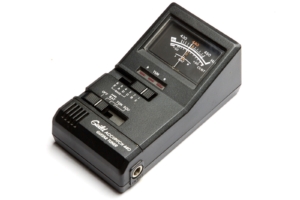 It’s no secret that I have a penchant for rare Guild items, including but not limited to stuff that other people just wouldn’t buy. Take this Guild-branded quartz tuner from the early 1980s, for example. Hey, at least I didn’t buy the one that was listed for $75!
It’s no secret that I have a penchant for rare Guild items, including but not limited to stuff that other people just wouldn’t buy. Take this Guild-branded quartz tuner from the early 1980s, for example. Hey, at least I didn’t buy the one that was listed for $75!
I thought it would be fun to write up what I could about this relic from a time before CDs when Star Trek II: The Wrath of Khan and E.T. the Extra-Terrestrial were both in theaters.
Introduction
 Listed on the back page of the 1982 AxCessories catalog from Guild, this Guild-branded tuner is actually a relatively generic unit that was also sold under the names Arion (Still in business) and apparently Piggy, though I’ve only seen a 45-year anniversary model for sale which says that it was a product made to celebrate the 45th anniversary of the Japanese store Ishibashi Music.
Listed on the back page of the 1982 AxCessories catalog from Guild, this Guild-branded tuner is actually a relatively generic unit that was also sold under the names Arion (Still in business) and apparently Piggy, though I’ve only seen a 45-year anniversary model for sale which says that it was a product made to celebrate the 45th anniversary of the Japanese store Ishibashi Music.
Manufactured by Prince Tsushinkogyo Ltd. in Japan, the tuner has the model name of AccuPitch 440 from Guild and HU-8100G by Arion (Arion tuners are also called Micons). The Piggy version seems to be nothing more than a rebranded Arion because it has the same HU-8100G part number.
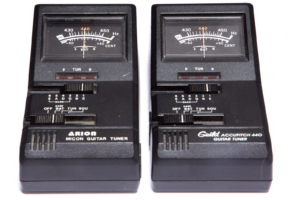 I went so far as to buy an Arion Micon HU-8100G just to prove my point and as you can see in this pic, the Arion is identical to the Guild Accupitch with the only exception being the logos. Having opened both of them up in my mad scientist’s laboratory, I can attest that they are indeed identical on the inside as well, right down to the advertised feature that isn’t apparent anywhere on the case (read on for more on that!)
I went so far as to buy an Arion Micon HU-8100G just to prove my point and as you can see in this pic, the Arion is identical to the Guild Accupitch with the only exception being the logos. Having opened both of them up in my mad scientist’s laboratory, I can attest that they are indeed identical on the inside as well, right down to the advertised feature that isn’t apparent anywhere on the case (read on for more on that!)
I do have to say that I find it fascinating that just looking at the two of them side by side, that I am drawn to the one on the right because it looks better. Why? Because of the Guild logo. I think I may be in too deep.
![]() Arion has made many tuners over the years with some looking like slight variations on the HU-8100G and others looking slightly more modern. Arion appears to still make a Micon needle/LED tuner with the part number HU-8400 which now supports chromatic tuning, a feature lacking on the old Guild.
Arion has made many tuners over the years with some looking like slight variations on the HU-8100G and others looking slightly more modern. Arion appears to still make a Micon needle/LED tuner with the part number HU-8400 which now supports chromatic tuning, a feature lacking on the old Guild.
The guild catalog copy states that the tuner has the following features:
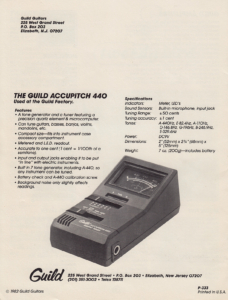 A tone generator and a tuner featuring a precision quartz element & microprocessor
A tone generator and a tuner featuring a precision quartz element & microprocessor- Can tune guitars, basses, banjos, violins, mandolins, etc.
- Compact size-fits into instrument case accessory compartment
- Metered and LED readout
- Accurate to one cent (1 cent = 1/100th of a semitone)
- Input and output jacks enabling it to be put “in line” with electric instruments
- Built in 7 tone generator, including A-440, so any instrument can be tuned
- Battery check and A-440 calibration screw
- Background noise only slightly affects readings
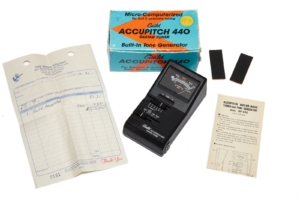 As an editorial note, I’ve removed the periods from the end of the bulleted items because the catalog doesn’t match my style guide (which is admittedly in my head and changes based on my caffeine intake). Let’s see if those marketing bullets line up with reality. But first, here’s an update from a few months after I published the original article because no matter how much I like to think I’m done when I publish something, something always seems to happen to pull me back in.
As an editorial note, I’ve removed the periods from the end of the bulleted items because the catalog doesn’t match my style guide (which is admittedly in my head and changes based on my caffeine intake). Let’s see if those marketing bullets line up with reality. But first, here’s an update from a few months after I published the original article because no matter how much I like to think I’m done when I publish something, something always seems to happen to pull me back in.
 I managed to find an almost new-in-box example of this tuner that included the original receipt from 1981 and even had the rubber “feet” that had never been applied. Not only that, but the original instructions which are shown here. When I wrote this article, I did not have the instructions and had to figure the unit out by trial and error, but I’m happy to say that I was correct so no modifications need be applied. I would like to point out that the instructions include a very happy cross-eyed representation of a person who “tuning by ear” which can be seen at the top right corner of the document. Buying this extra example was totally worth it just for that and in no way had anything to do with Kurt from The Guilds of Grot mocking me for his Accupitch tuner that still had the original box.
I managed to find an almost new-in-box example of this tuner that included the original receipt from 1981 and even had the rubber “feet” that had never been applied. Not only that, but the original instructions which are shown here. When I wrote this article, I did not have the instructions and had to figure the unit out by trial and error, but I’m happy to say that I was correct so no modifications need be applied. I would like to point out that the instructions include a very happy cross-eyed representation of a person who “tuning by ear” which can be seen at the top right corner of the document. Buying this extra example was totally worth it just for that and in no way had anything to do with Kurt from The Guilds of Grot mocking me for his Accupitch tuner that still had the original box.
 Sure, I now have three of the damn things, one of which has the original box, instructions and receipt (not that that’s important) and one of them doesn’t say Guild on it, but on the plus side all together they only cost me about a hundred bucks for tuners that I’ll never use.
Sure, I now have three of the damn things, one of which has the original box, instructions and receipt (not that that’s important) and one of them doesn’t say Guild on it, but on the plus side all together they only cost me about a hundred bucks for tuners that I’ll never use.
And no – you can’t have any of them.
Operation
 This tuner has an input jack on the right side and an output jack on the left. There is an analog meter that works in conjunction with the LED meter. Sadly one of the LEDs was defunct on my unit, but I fixed it because what kind of mad scientist would I be if I couldn’t fix an LED on an ’80s tuner?
This tuner has an input jack on the right side and an output jack on the left. There is an analog meter that works in conjunction with the LED meter. Sadly one of the LEDs was defunct on my unit, but I fixed it because what kind of mad scientist would I be if I couldn’t fix an LED on an ’80s tuner?
This tuner can be used as a standalone device where you plug the guitar into the input jack, pluck (pick, more likely) a string and read the results on both the analog needle and the LED display. The downside of a tuner like this is that you have to choose which note you want to tune or you won’t get any useful results and it only has six options that correspond to the strings on a guitar in standard tuning.
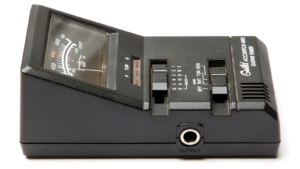 Another downside of a tuner this old is that it is not chromatic, which means that it will only tune to the six normal guitar strings E, A, D, G, B, and E. Well, that’s not strictly true because this tuner will also tune to A-440 which is 440Hz whereas the guitar’s A string in standard tuning is 110 Hz (A2 on a piano or anywhere that real musical notation is common such as almost any instrument other than the guitar).
Another downside of a tuner this old is that it is not chromatic, which means that it will only tune to the six normal guitar strings E, A, D, G, B, and E. Well, that’s not strictly true because this tuner will also tune to A-440 which is 440Hz whereas the guitar’s A string in standard tuning is 110 Hz (A2 on a piano or anywhere that real musical notation is common such as almost any instrument other than the guitar).
Technically, you could tune to a half-semitone up or down by using the analog scale which is graduated on the bottom in 10-cent increments with -50 and +50 clearly indicated. Unfortunately that means that a tuning as simple as E♭is not possible because the best you can do is E♭and ½ which is a bit nutty unless you’re into microtonalism or early Van Halen albums.
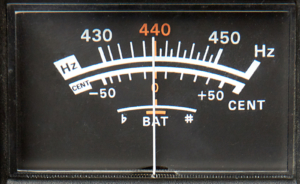 Similarly, there is no way to tune a half or whole step down (or up) since the tuner will only report on the six strings of standard tuning, though the tuner makes point of labeling the first four strings as being useful for bass tuning, so you’ve got that going for you so long as you don’t deviate from the norm.
Similarly, there is no way to tune a half or whole step down (or up) since the tuner will only report on the six strings of standard tuning, though the tuner makes point of labeling the first four strings as being useful for bass tuning, so you’ve got that going for you so long as you don’t deviate from the norm.
The top slider switch lets you chose from the six standard-tuning strings and will function in both TUN mode and the SOU mode, which brings us to the bottom slider switch.
The bottom slider has four positions labeled:
- OFF
- BAT (A440)
- TUN
- SOU
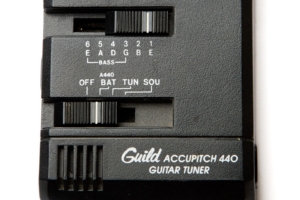 OFF is what you think it is. Unfortunately, this being a device from 1982, it does not turn itself off and if you leave it on, it will stay on until the battery dies. Bummer.
OFF is what you think it is. Unfortunately, this being a device from 1982, it does not turn itself off and if you leave it on, it will stay on until the battery dies. Bummer.
BAT (A440) is both a battery meter and a tone generator but since this tuner does not have a speaker the tones are generated only through the Output jack. When the battery is fully charged, the meter will be in the center as shown in the last couple of images. When plugged in, that A440 tone that we all know and love is sent to the amps for the audience to enjoy.
TUN is short for Tuner and is likely the mode in which the average guitarist would find themselves most often. In this mode, with the upper switch selecting the proper string, a note is played on the guitar and the needle and LEDs indicate if you are within 50 cents of the note in either direction (sharp or flat). The LED seems to consider “in tune” to be anything within 50 cents plus or minus the actual frequency being tested which makes the LEDs 100% useless in my mind. Note that unlike many modern pedal tuners, this unit does not mute the signal while tuning so your audience can enjoy your tuning almost as much as your bandmates.
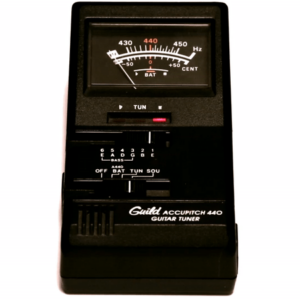 One of the cooler features is that the tuner has a little microphone which is visible on the top near the Guild logo. This mic is useful because you can use the tuner without connecting it to anything. Just turn the tuner on, select a string, and play a nice loud high-gain B and the tuner will report on the tuning status of said B, and since the ad copy states that background noise only slightly affects readings the resulting boos from the audience while you tune at volume probably won’t affect the unit’s performance. Yay technology!
One of the cooler features is that the tuner has a little microphone which is visible on the top near the Guild logo. This mic is useful because you can use the tuner without connecting it to anything. Just turn the tuner on, select a string, and play a nice loud high-gain B and the tuner will report on the tuning status of said B, and since the ad copy states that background noise only slightly affects readings the resulting boos from the audience while you tune at volume probably won’t affect the unit’s performance. Yay technology!
Also, I guess you could use the microphone feature to tune things like orchestral instruments provided that you want to tune them to a guitar’s standard tuning since there is no capability to tune to A400 aside from just matching the tone from the BAT (A440) setting by ear—which requires an amp since there’s no speaker.
[dropshadowbox align=”right” effect=”raised” width=”” height=”” background_color=”#ffffff” border_width=”1″ border_color=”#dddddd” ]Accupitch 440 Tones
[/dropshadowbox]SOU is short for Sound which should really be labeled TON for Tone Generator, though I’d imaging TON would easily be confused with TUN. In this setting, the unit does nothing but generate tone so that you can tune by ear. Again, there is no speaker, so tuning using this method requires cabling the tuner up to an amplifier. When in this mode, the LEDs light in sequence from left-to-right repeatedly to indicate that you can’t use them for tuning. Or because it’s cool. You can hear the tones generated in the attached sound clip which includes, in order, E,A,D,G,B,E and A-440. Note the sort of slow ramp-up on the last A-440 sample. This was fairly common in my testing and seems to be indicative of how this ’80s tech seemed to function.Gooey Gadget Guts
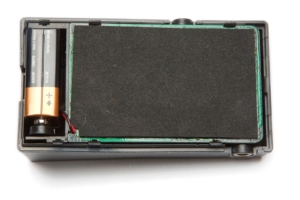 The ad copy says that there is an A-440 calibration screw, but I couldn’t find one anywhere. So I did what I do and I took the tuner apart.
The ad copy says that there is an A-440 calibration screw, but I couldn’t find one anywhere. So I did what I do and I took the tuner apart.
In order to gain access to the battery, the entire back comes off with a slight push of a latch. I should note that the entire case is plastic and holds together with plastic tabs, so I imagine it would be very easy to break thus making these old tuners even harder to find in good condition if you’re on the hunt for one. With the back off, I was stymied by rubber foam that was glued to the back of the circuit board. Of course, that didn’t stop me.
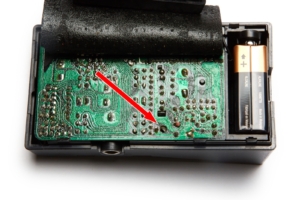 After carefully peeling back the foam, being careful not to tear it, I found a hole on the circuit board with a small potentiometer visible through the entrance. This is not exactly what I would call a user-serviceable adjustment point, but it’s there so I suppose I can’t say that the marketing material was incorrect. I should also point out that this unit was pretty spot-on and didn’t need adjustment after some 37 years, so I suppose that’s not such a big deal. At least now we know where it is should someone desperately need to adjust theirs.
After carefully peeling back the foam, being careful not to tear it, I found a hole on the circuit board with a small potentiometer visible through the entrance. This is not exactly what I would call a user-serviceable adjustment point, but it’s there so I suppose I can’t say that the marketing material was incorrect. I should also point out that this unit was pretty spot-on and didn’t need adjustment after some 37 years, so I suppose that’s not such a big deal. At least now we know where it is should someone desperately need to adjust theirs.
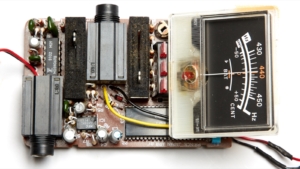 The circuit board is held in place by four plastic tabs and after gently bending the case (as opposed to the tabs themselves) I managed to get the guts out without damaging anything.
The circuit board is held in place by four plastic tabs and after gently bending the case (as opposed to the tabs themselves) I managed to get the guts out without damaging anything.
I was bummed to discover upon unpacking this tuner that one of the LEDs was not working. With the guts out I’m happy to say that I discovered the problem to be a bad solder joint on the offending LED which I was able to repair. Man, if there’s one thing that makes me happy it’s being able to bring old electronics back to life.
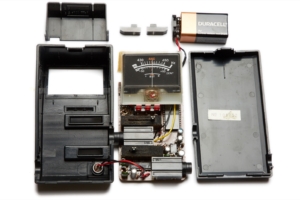 With the tuner fixed and the A440 adjustment pot located, I took a few pics and proceeded to put the entire thing back together.
With the tuner fixed and the A440 adjustment pot located, I took a few pics and proceeded to put the entire thing back together.
A quick note to anyone who decides to do this: Be careful when reassembling the case because the LEDs, if not lined up with their holes, may get crushed or have their legs bend to the point of breaking which I think might be what happened to mine. Also, there’s a little plastic battery enclosure that you can see on the top left of that last pic. If you put the whole thing back together and the battery is flopping around in the case, you probably forgot to snap that back into place like I did.
Real Use
In practice, this old tuner (and I’d imagine any tuner this old) is a bit annoying, especially when compared to the myriad ubiquitous tuning options available to guitarists today. This thing would have been cool as hell back in the early ’80s because there really wasn’t anything else. When I was in high school band we had one of those huge Peterson strobe tuners (Actually ours was a Conn like this one) and that was the first tuner I’d ever seen. For years I tuned my guitar with an A440 tuning fork that stayed in my case. I still have it in the drawer in my home office in case I need to tune my guitar after the apocalypse. We’ll see who’s prepared.
Today I have an Axe-FX III that has an amazing tuner built in that I can reference from my MIDI foot controller and that I can also use on a laptop via USB. I also have one of those little Super Snark tuners in my case that I never use because the one in the Axe-FX is so good. My daughter has an acoustic with an on-board tuner built into the preamp. When I play through a real amp I use a small pedal board that has a kick-ass Turbo Tuner that I adore. Hell, I even have the Peterson Strobo-Tuner app on my iPhone which works with the same visual cues as that old Conn I used in high school. That iPhone app is my go-to with acoustic guitars because it’s always on me. Hell, I could buy the current Guild Tuner if the desire struck me.
 When turned off, the needle rests on the right side of the meter, which always seemed a bit odd to me. With the BAT (A440) position selected, the needle will be dead center as shown in the previous pics. I find it kind of odd that the meter is marked with a scale surrounding A440 since it does not appear possible to tune to A440 which means that scale is only for calibration which should be a rare event as evidenced by the fact that this one is spot-on after 37 years. Honestly, I’d imagine that no one actually reads the scale, though I do know of people who like to tune certain strings a few cents sharp, so it seems to me that cents scale being on top (and thus larger) would have been more logical. And, of course, when tuning, the needle will represent how close your string is tuned to the target note with the A440 mark being that note, which I think is dumb.
When turned off, the needle rests on the right side of the meter, which always seemed a bit odd to me. With the BAT (A440) position selected, the needle will be dead center as shown in the previous pics. I find it kind of odd that the meter is marked with a scale surrounding A440 since it does not appear possible to tune to A440 which means that scale is only for calibration which should be a rare event as evidenced by the fact that this one is spot-on after 37 years. Honestly, I’d imagine that no one actually reads the scale, though I do know of people who like to tune certain strings a few cents sharp, so it seems to me that cents scale being on top (and thus larger) would have been more logical. And, of course, when tuning, the needle will represent how close your string is tuned to the target note with the A440 mark being that note, which I think is dumb.
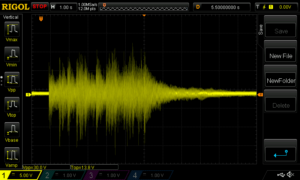 This tuner exhibits some pretty significant tone-suck which I noticed by playing through it into a high-gain amp. The tone was just not there with the tuner inline, so I decided to pull out some real tools and measure what was going on because, “it sucks” is just not good enough, or so every manager I’ve ever had tells me.
This tuner exhibits some pretty significant tone-suck which I noticed by playing through it into a high-gain amp. The tone was just not there with the tuner inline, so I decided to pull out some real tools and measure what was going on because, “it sucks” is just not good enough, or so every manager I’ve ever had tells me.
My test consisted of the guitar being connected to my Rygol Oscilloscope with a BNC-to-alligater-clip that I clipped to the contacts within the phono jack on the end of my Lava cable. This first output is the guitar right into the oscilloscope. I then proceeded to bang on the strings Pete Townsend style in an effort to produce as much signal as possible. I did this a few times and selected the highest output I recorded, which is shown here. There are two measurements on the bottom but I’m going to be looking at the first one: Vpp (Voltage peak-to-peak) which is the highest amount of voltage from top to bottom. The absolute highest signal I could produce was 30.0V which is 15V above the center and 15V below (each square is 5V in this output).
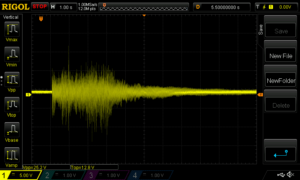 Next, I unplugged the cable from the guitar and plugged it into the output jack on the tuner. I then plugged another Lava cable from the input on the tuner to the guitar. With this simple setup (guitar -> Accupitch-440 -> Oscilloscope) I repeated my test and beat upon the guitar mightily. This time the most output I could produce was 25.2V, which is a significant difference. If that doesn’t seem like much, remember that this is the absolute peak, and while I thought about doing the test again while measuring for peak and RMS (Root Mean Squared), I felt that I had made my point and lost interest. Honestly, just look at the pics. That’s what tone-suck looks like.
Next, I unplugged the cable from the guitar and plugged it into the output jack on the tuner. I then plugged another Lava cable from the input on the tuner to the guitar. With this simple setup (guitar -> Accupitch-440 -> Oscilloscope) I repeated my test and beat upon the guitar mightily. This time the most output I could produce was 25.2V, which is a significant difference. If that doesn’t seem like much, remember that this is the absolute peak, and while I thought about doing the test again while measuring for peak and RMS (Root Mean Squared), I felt that I had made my point and lost interest. Honestly, just look at the pics. That’s what tone-suck looks like.
Finally, not only does this tuner not have true-bypass, it simply cannot be bypassed! In other words the tone-suck remains even when the tuner is turned off, so the feature that says Input and output jacks enabling it to be put “in line” with electric instruments while technically true, is really not in practice because the tuner has a pretty significant affect on the signal.
Conclusion
 Would I buy one of these today? Well, I guess I did, so the real question is would I recommend it to others? Sure, if you’d like to get a feel for what it was like to be a guitarist in the early ’80s when this was tech worthy of being on the back cover of a major guitar companies accessory catalog. Otherwise, not so much.
Would I buy one of these today? Well, I guess I did, so the real question is would I recommend it to others? Sure, if you’d like to get a feel for what it was like to be a guitarist in the early ’80s when this was tech worthy of being on the back cover of a major guitar companies accessory catalog. Otherwise, not so much.
First of all, you can get generic ones for $20 online, and honestly that’s too much because for $20 you can buy a Snark at any music store. Actually, you can probably buy two. Secondly, here in the middle of 2019 even $9 tuners are far more advanced than this old thing. As a piece of ’80s Guild nostalgia, though, it’s pretty cool, even if it will spend the rest of its life sitting on my bookshelf.
And no, you can’t have mine.
Donate: PayPal Crypto:
ETH: 0x0AC57f8e0A49dc06Ed4f7926d169342ec4FCd461
Doge: DFWpLqMr6QF67t4wRzvTtNd8UDwjGTQBGs
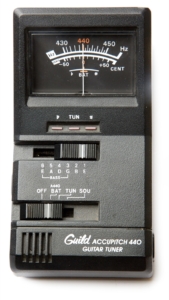
A very interesing and amusing review on this tuner – thank you!
I found your page as I have the Arion version of this tuner (which I still use as I am too tightfisted to buy a new tuner) but it is a pain to use, for the reasons you state. I always wondered what the SOU setting was all about (I guessed it was short for Sound) but have never plugged an amp into the output so that explains it!
Incidently, there is a Piggy version on ebay at the moment: https://www.ebay.com/itm/184968236361?mkrid=711-53200-19255-0&siteid=0&mkcid=1&campid=5335816800&toolid=10001&customid=bgp&mkevt=1
Kind regards, Ian